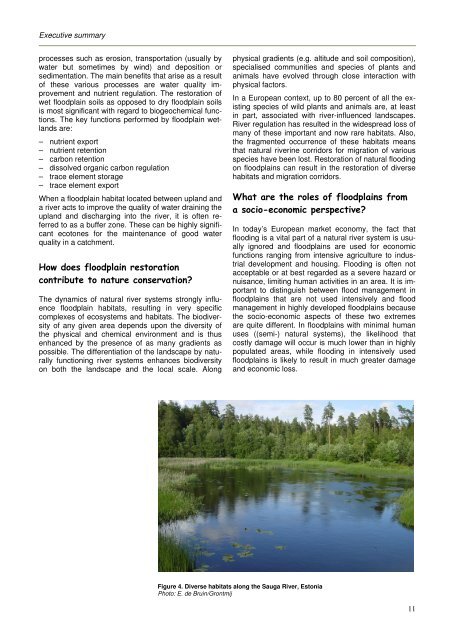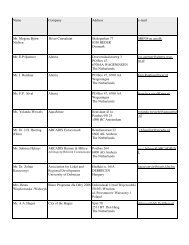HOW TO USE FLOODPLAINS FOR FLOOD RISK ... - SGGW
HOW TO USE FLOODPLAINS FOR FLOOD RISK ... - SGGW
HOW TO USE FLOODPLAINS FOR FLOOD RISK ... - SGGW
Create successful ePaper yourself
Turn your PDF publications into a flip-book with our unique Google optimized e-Paper software.
Executive summary<br />
processes such as erosion, transportation (usually by<br />
water but sometimes by wind) and deposition or<br />
sedimentation. The main benefits that arise as a result<br />
of these various processes are water quality improvement<br />
and nutrient regulation. The restoration of<br />
wet floodplain soils as opposed to dry floodplain soils<br />
is most significant with regard to biogeochemical functions.<br />
The key functions performed by floodplain wetlands<br />
are:<br />
– nutrient export<br />
– nutrient retention<br />
– carbon retention<br />
– dissolved organic carbon regulation<br />
– trace element storage<br />
– trace element export<br />
When a floodplain habitat located between upland and<br />
a river acts to improve the quality of water draining the<br />
upland and discharging into the river, it is often referred<br />
to as a buffer zone. These can be highly significant<br />
ecotones for the maintenance of good water<br />
quality in a catchment.<br />
. , -<br />
The dynamics of natural river systems strongly influence<br />
floodplain habitats, resulting in very specific<br />
complexes of ecosystems and habitats. The biodiversity<br />
of any given area depends upon the diversity of<br />
the physical and chemical environment and is thus<br />
enhanced by the presence of as many gradients as<br />
possible. The differentiation of the landscape by naturally<br />
functioning river systems enhances biodiversity<br />
on both the landscape and the local scale. Along<br />
1<br />
physical gradients (e.g. altitude and soil composition),<br />
specialised communities and species of plants and<br />
animals have evolved through close interaction with<br />
physical factors.<br />
In a European context, up to 80 percent of all the existing<br />
species of wild plants and animals are, at least<br />
in part, associated with river-influenced landscapes.<br />
River regulation has resulted in the widespread loss of<br />
many of these important and now rare habitats. Also,<br />
the fragmented occurrence of these habitats means<br />
that natural riverine corridors for migration of various<br />
species have been lost. Restoration of natural flooding<br />
on floodplains can result in the restoration of diverse<br />
habitats and migration corridors.<br />
- /<br />
2 / - - 1<br />
In today’s European market economy, the fact that<br />
flooding is a vital part of a natural river system is usually<br />
ignored and floodplains are used for economic<br />
functions ranging from intensive agriculture to industrial<br />
development and housing. Flooding is often not<br />
acceptable or at best regarded as a severe hazard or<br />
nuisance, limiting human activities in an area. It is important<br />
to distinguish between flood management in<br />
floodplains that are not used intensively and flood<br />
management in highly developed floodplains because<br />
the socio-economic aspects of these two extremes<br />
are quite different. In floodplains with minimal human<br />
uses ((semi-) natural systems), the likelihood that<br />
costly damage will occur is much lower than in highly<br />
populated areas, while flooding in intensively used<br />
floodplains is likely to result in much greater damage<br />
and economic loss.<br />
Figure 4. Diverse habitats along the Sauga River, Estonia<br />
Photo: E. de Bruin/Grontmij<br />
11




